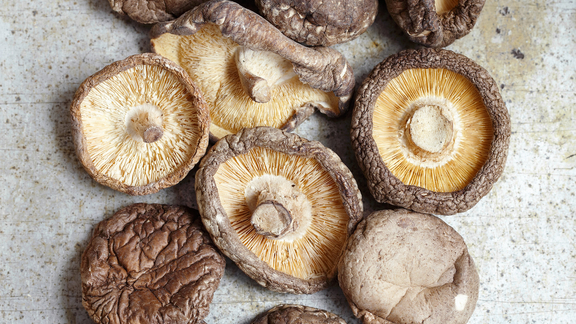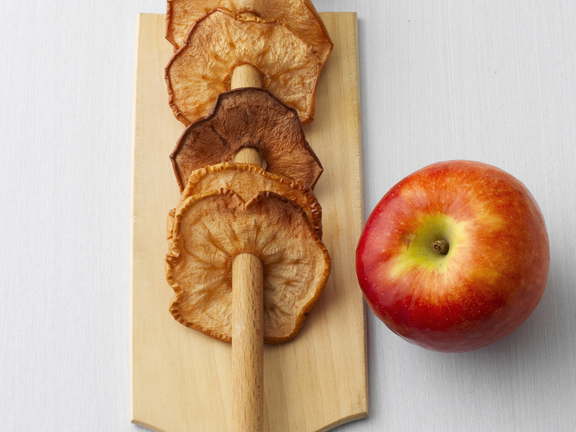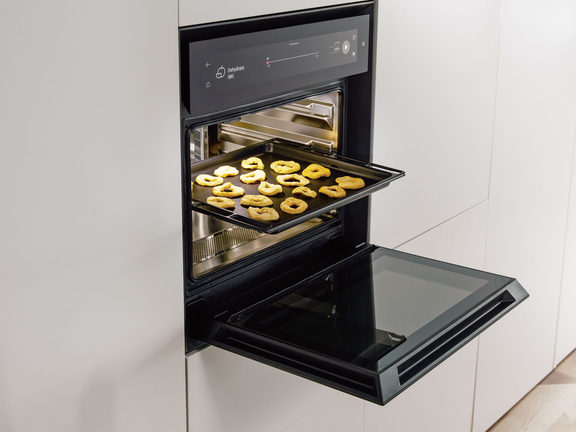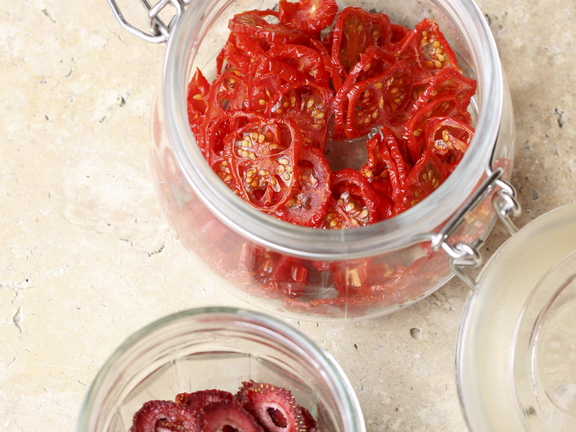

Extract water, preserve and enjoy: Dehydrating involves drying food in a targeted manner.
This extends the shelf life, intensifies the flavour - and makes it more versatile.
You can conjure up delicious dishes from fruit and vegetables, herbs, fish and meat. However, ingredients only have a short shelf life and most require cool, dry storage. This can be changed: Drying makes food last longer in no time without additives and loss of nutrientsand the lower water content intensifies the flavours. How does the method work?
It's simple: you dehydrate food by spreading it out on a rack or hanging it and exposing it to warm, dry air. The higher the air temperature, the quicker the process. The optimum residual moisture to prevent the food from spoiling during storage varies from food to food. For herbs, for example, the residual moisture is between 5 and 12 per cent.
Tip: Weigh the dried food before and after drying. This way, you can easily determine the residual moisture of the food.
Dried fruit as a snack or ingredient for cooking and baking, savoury beef jerky, mushrooms with a longer shelf life - numerous foods are ideal for dehydrating:

Wanted tips for clever stockpiling? Simply grow your own vegetables.
Drying is possible with the oven as well as with special machines or in the air. Which method is best? You decide:

Tip: Wash and dry the food thoroughly before dehydrating and cut into thin slices. Ideally, these should be less than 0.5 centimetres thick, otherwise complete drying will take considerably longer. This will give you an optimum, even result.

The BORA X BO steam oven is your multi-tool for creative cooking projects.
Airtight containers such as screw-top jars or vacuum boxes are perfect for storage.
Tip: With the BORA QVac built-in vacuum sealer, you can vacuum seal your food quickly and conveniently.

After dehydration is before consumption: Dehydrated food can be used in many ways:
How long and at what temperature to dehydrate which foods? The table tells you. The dehydration time varies depending on the appliance capacity and the moisture content of the food you are dehydrating.
| Drying food | Drying time/h | Temperature/°C |
|---|---|---|
| Apples | 3-4 (cut thickness 4-6 mm) | 70-90 |
| Apricots | 13-17 | 60-80 |
| Vegetable crisps | 1-3 (cut thickness 2-3 mm) | 90-120 |
| Celery | 7-12 (cut thickness 3-4 mm | 70 |
| Tomatoes* | 8-10 | 70-80 |
| Mushrooms | 3-4 (cutting thickness 4 mm) | 50 |
| Herbs | 3 | 90 |
| Beef | 6 (cutting thickness 3-5 mm) | 50-80 |
The functions of the BORA X BO are designed for a fast cooking time and a dry or crispy result. crispy result.
*Small tomatoes can be quartered or halved and then dehydrated. They will keep for around two weeks once dried. Profit tip: Marinating in oil, optionally with herbs and garlic, extends the shelf life.
Dried foods have a longer shelf life without refrigeration, and the drying process causes them to shrink, making them easier to store in a space-saving way. Drying at low temperatures helps preserve nutrients optimally. In many dried foods, the flavors become more intense, offering a completely new taste experience. You can also reduce food waste by drying seasonal produce and enjoying it year-round with a low carbon footprint.
Some foods are not suitable for drying, especially high-fat items such as avocado, sausages, fatty meats, oily fish, and eggs. Unripe foods or those with bruises or signs of decay should also generally not be dehydrated.
If the residual moisture of the food is reduced according to guidelines and the dried goods are stored in a dry place—ideally vacuum-sealed—they can last one to two years.
Due to their low moisture content, dried foods are packed with fiber, vitamins, and minerals. Since drying reduces the water content of food, the nutrients are concentrated per gram. This increases the nutritional value in relation to the mass.